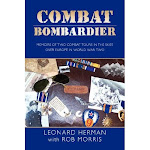
Marilyn Walton sent me some good links dealing with the famous Norden bombsight, which legend has it could drop a bomb into a pickle barrel from twenty thousand fee (though only under ideal conditions and rarely when an aircraft was in less than perfect weather or was being shot at or flakked up. At the end of the article are two websites Marilyn recommended on the Norden bombsight. I checked them both and they are very interesting. According to Marilyn, Carl Norden sold his invention to the war effort for one dollar.
In the wiki story below, if you click on the blue hyperlinks, you can get additional information on the topics:
"Design and operation
The Norden sight was designed for use on US Navy aircraft by Carl Norden, a Dutch engineer educated in Switzerland who emigrated to the US in 1904 and worked on bombsights at the Sperry Corporation before starting his own company. The Norden was initially built at the Norden plant in New York City before the start of WWII and then at several other companies during the war. The device used a mechanical analog computer comprising electric motors, gyros, mirrors, bubble levels, gears and a small telescope.

The bombardier would input the necessary information, such as airspeed and altitude, and the bombsight would calculate the trajectory of the bomb being dropped. Near the target the aircraft would fly on autopilot to a precise position calculated by the bombsight and release the ordnance. Using this device, bombardiers could, in theory, drop their bombs within a 100-foot (ca 30m) circle from an altitude of well over 20,000 feet (ca. 7km). In combat, this accuracy was never achieved — because the Norden had been tested under "artificial conditions" at the US proving grounds, for example in the absence of anti-aircraft fire or adverse weather. An additional factor was that the shape and even the paint of the bomb mantle greatly changed the aerodynamic properties of the weapon; and, at that time, nobody knew how to calculate the trajectory of bombs that reached supersonic speeds during their fall.

Under perfect conditions only 50 percent of American bombs fell within a quarter of a mile of the target, and American flyers estimated that as many as 90 percent of bombs could miss their targets.

Operational efficiency
The "Norden" was marketed as the tool to win the war; and it was often claimed that the bombsight could drop bombs into pickle barrels. As noted above, the bombsight's effectiveness is debated. Some argue that over typically cloud-covered Europe the Norden was nearly useless, and the British Bomber Command focused on nighttime bombing anyway. However, the United States Army Air Forces (USAAF) did both day and night bombing runs, depending on the distance; and many veteran B-17 and B-24 bombardiers swore by the Norden.
In the European theater, the US introduced an Automatic Flight Control Equipment (AFCE) and a radar system called the H2X (Mickey), which were used directly with the Norden bombsight. The AFCE served as the mechanical computer “autopilot” of the plane. The radar proved most accurate in coastal regions, as the water surface and the coastline produced a distinctive radar echo.
Over Japan, bomber crews soon discovered strong winds at high altitudes, the so-called jetstreams — but the Norden bombsight worked only for wind speeds with minimal wind shear, under which testing had been done. Additionally, the bombing altitude over Japan reached up to 30,000 feet — but most of the testing had been done well below 20,000 ft.
In both theaters of war, one vulnerability was that, when the bombardier auto-piloted the aircraft using the bombsight, the aircraft was more susceptible to anti-aircraft fire and collisions with other allied aircraft.
As a mechanical device, the Norden bombsight used complex machinery consisting of many gearwheels and ball bearings, which were prone to produce inaccuracies if not properly maintained. In fact, many bombsights were rushed to war use without thorough testing. Often the bombardier had to oil and repair failures himself – for some time into the war, equipped and qualified groundcrew technical staff were just not available in sufficient numbers (see below).
Wartime security
As a critical wartime instrument, bombardiers were required to take an oath during their training stating that they would defend the Norden secret with their own life if necessary. In case the bomber plane should make an emergency landing on enemy territory, the bombardier would have to shoot the important parts of the "Norden" with a gun, disabling it; but as this method still would leave a nearly intact apparatus to the enemy, something like a thermite gun was installed – the sheer heat of the chemical reaction would melt the "Norden" into a lump of metal.
After each completed mission, bomber crews left the aircraft with a bag which they deposited in a safe ("the Bomb Vault"). This secure facility ("the AFCE and Bombsight Shop") was typically in one of the base's Nissen hut (Quonset hut) support buildings. The Bombsight Shop was manned by enlisted men who were members of a Supply Depot Service Group ("Sub Depot") attached to each USAAF bombardment group. These shops not only guarded the bombsights but performed critical maintenance on the Norden and related control equipment. This was probably the most technically skilled ground-echelon job, and certainly the most secret, of all the work performed by Sub Depot personnel. The non-commissioned officer in charge and his staff had to have a high aptitude for understanding and working with mechanical devices.
As the end of World War II neared, the bombsight was gradually downgraded in its secrecy; however, it was not until 1944 that the first public display of the instrument occurred.
Its last use in combat was by the Naval Air Observation Squadron Sixty-Seven (VO-67), during the Vietnam War. The bombsights were used in Operation Igloo White for dropping Air-Delivered Seismic Intrusion Detectors (ADSID) along the Ho Chi Minh Trail. " ---End Wikipedia article
Further reading at these websites: http://www.nordenretireesclub.org/norden_bio.htm






No comments:
Post a Comment